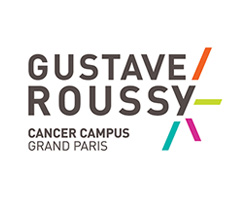Study of the mechanism of action of interferon alpha in classical myeloproliferative neoplasms
Etude du mécanisme d'action de l'interféron alpha dans les néoplasmes myéloprolifératifs classiques
Résumé
Classical BCR-ABL-negative myeloproliferative neoplasms (MPN) include Polycythemia Vera (PV), Essential Thrombocytemia (ET) and Primary Myelofibrosis (PMF). They are acquired clonal disorders of hematopoietic stem cells (HSC) leading to the hyperplasia of one or several myeloid lineages. They are due to three main recurrent mutations affecting the JAK/STAT signaling pathway: JAK2V617F and mutations in calreticulin (CALR) and thrombopoietin receptor (MPL). Interferon alpha (IFNα) is the only curative treatment that induces not only a hematological response of ET, PV and early MF but also a molecular response both on JAK2V617F or CALR mutated cells. In this study, we wanted to know how and with what kinetics IFN impacts the different mutated hematopoietic compartments. Thus, we have performed a prospective study with a cohort of 50 patients treated by IFNα for 3-5 years. The MPN diseases distribution was 44% ET, 45% PV and 11% MF. This cohort included 33 JAK2V617F-mutated patients, 11 CALR-mutated patients (7 type 1/type 1-like and 4 type 2/type 2-like), 2 both JAK2V617F- and CALR-mutated patients and 1 MPLW515K-mutated patient. At 4-month intervals, the JAK2V617F or/and CALR mutation variant allele frequency was measured in mature cells (granulocytes, platelets). Simultaneously, we have also determined the clonal architecture by studying the presence of the JAK2V617F or CALR mutations in colonies derived from the different hematopoietic stem and progenitor cell (HSPC) populations (CD90+CD34+CD38- HSC-enriched progenitors, CD90-CD34+CD38- immature progenitors and CD90- CD34+CD38+ committed progenitors). After a median follow-up of 30 months, we observed that IFNα targets more efficiently and rapidly the HSPC particularly in HSC-enriched progenitors, than the mature blood cells in JAK2V617F patients (p<.05). Moreover, homozygous JAK2V617F clones responded more rapidly than heterozygous clones in all hematopoietic cell compartments showing that the intensity of JAK2V617F signaling is correlated with the efficacy of IFNα. These observations were slightly increased after a median follow-up of 51 months. In contrast, with a median follow-up of 30 months for CALR mutated patients, IFNα targeted similarly the HSPC and the mature cells. Moreover, IFNα induced a less rapid response to target CALR-mutated HSPC than the JAK2V617F HSPC (p<.05). The role of associated mutations at diagnosis was also investigated in the IFNα-mediated HSPC molecular responses using a NGS targeted myeloid panel. While in JAK2V617F-mutated patients, we found that the number of associated mutations did not impact the HSPC molecular response of the JAK2V617F clone, in CALR-mutated patients, even if the number of cases was low, the only molecular responders were those not associated with other mutations. Using Ba/F3-MPL cellular models and primary cells, we observed that JAK2V617F was more prone to sensitize to IFNα signaling (increased Phospho-STAT1 and IFN-stimulating genes (ISGs)) compared to controls or CALRdel52 mutated cells.Altogether, our results show that IFNα differentially targets the human JAK2V617F- and CALR-mutated HSPC and mature cells. Moreover, the molecular response was dependent not only on the JAK2V617F or CALR mutated status but also on the presence of other associated mutations.
Les néoplasmes myéloprolifératifs classiques sont des maladies clonales dues à des mutations acquises de JAK2V617F ou de la Calréticuline (CALRm) au niveau des cellules souches hématopoïétiques (CSH) et conduisant à une surproduction de cellules myéloïdes. L’interféron alpha (IFNa) est le seul traitement curatif qui induit une réponse hématologique et moléculaire. Le but de notre projet est de comprendre son mécanisme d’action en utilisant une cohorte de 47 patients, des lignées cellulaires et des modèles de souris JAK2V617F. Ainsi, nous avons constaté que l’IFNa cible plus rapidement les CSH que les cellules matures chez les patients JAK2V617F, ce qui semble différent des patients CALRm. Grâce aux lignées cellulaires et aux souris, nous avons montré que JAK2V617F induit une pré-activation des voies de l’IFNa et une inhibition du cycle cellulaire des CSH. La découverte complète de ce mécanisme d’action conduira à l’amélioration du traitement.
Origine : Version validée par le jury (STAR)
Loading...

